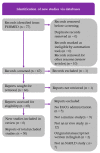Salubrious Effects of Green Tea Catechins on Fatty Liver Disease: A Systematic Review
- PMID: 35323719
- PMCID: PMC8949532
- DOI: 10.3390/medicines9030020
Salubrious Effects of Green Tea Catechins on Fatty Liver Disease: A Systematic Review
Abstract
Epigallocatechin-3-gallate (EGCG) is a polyphenol green tea catechin with potential health benefits and therapeutic effects in non-alcoholic fatty liver disease (NAFLD), a common liver disorder that adversely affects liver function and lipid metabolism. This systematic review surveyed the effects of EGCG or green tea extract (GTE) on NAFLD reported in studies involving rodent models or humans with a focus on clinicopathologic outcomes, lipid and carbohydrate metabolism, and inflammatory, oxidative stress, and liver injury markers. Articles involving clinical efficacy of EGCG/GTE on human subjects and rodent models were gathered by searching the PUBMED database and by referencing additional articles identified from other literature reviews. EGCG or GTE supplementation reduced body weight, adipose tissue deposits, and food intake. Mechanistically, the majority of these studies confirmed that EGCG or GTE supplementation plays a significant role in regulating lipid and glucose metabolism and expression of genes involved in lipid synthesis. Importantly, EGCG and GTE supplementation were shown to have beneficial effects on oxidative stress-related pathways that activate pro-inflammatory responses, leading to liver damage. In conclusion, green tea catechins are a potentially useful treatment option for NAFLD. More research is required to determine the ideal dosage, treatment duration, and most effective delivery method of EGCG or GTE, and to provide more definitive conclusions by performing large, randomized clinical trials.
Keywords: epigallocatechin-3-gallate; green tea extracts; non-alcoholic fatty liver disease.
Conflict of interest statement
The authors declare no conflict of interest.
Figures




Similar articles
-
Preparation and antioxidant activity of green tea extract enriched in epigallocatechin (EGC) and epigallocatechin gallate (EGCG).J Agric Food Chem. 2009 Feb 25;57(4):1349-53. doi: 10.1021/jf803143n. J Agric Food Chem. 2009. PMID: 19182914
-
Epigallocatechin gallate but not catechin prevents nonalcoholic steatohepatitis in mice similar to green tea extract while differentially affecting the gut microbiota.J Nutr Biochem. 2020 Oct;84:108455. doi: 10.1016/j.jnutbio.2020.108455. Epub 2020 Jun 20. J Nutr Biochem. 2020. PMID: 32688217
-
EGCG and catechin relative to green tea extract differentially modulate the gut microbial metabolome and liver metabolome to prevent obesity in mice fed a high-fat diet.J Nutr Biochem. 2022 Nov;109:109094. doi: 10.1016/j.jnutbio.2022.109094. Epub 2022 Jun 29. J Nutr Biochem. 2022. PMID: 35777589 Free PMC article.
-
United States Pharmacopeia (USP) comprehensive review of the hepatotoxicity of green tea extracts.Toxicol Rep. 2020 Feb 15;7:386-402. doi: 10.1016/j.toxrep.2020.02.008. eCollection 2020. Toxicol Rep. 2020. PMID: 32140423 Free PMC article. Review.
-
Safety assessment of green tea based beverages and dried green tea extracts as nutritional supplements.Toxicol Lett. 2017 Aug 5;277:104-108. doi: 10.1016/j.toxlet.2017.06.008. Epub 2017 Jun 24. Toxicol Lett. 2017. PMID: 28655517 Review.
Cited by
-
Epigallocatechin-3-Gallate, an Active Green Tea Component to Support Anti-VEGFA Therapy in Wet Age-Related Macular Degeneration.Nutrients. 2023 Jul 28;15(15):3358. doi: 10.3390/nu15153358. Nutrients. 2023. PMID: 37571296 Free PMC article. Review.
-
Complementary and alternative medicines and liver disease.Hepatol Commun. 2024 Apr 3;8(4):e0417. doi: 10.1097/HC9.0000000000000417. eCollection 2024 Apr 1. Hepatol Commun. 2024. PMID: 38563584 Free PMC article. Review.
-
Green Tea Catechins Attenuate Neurodegenerative Diseases and Cognitive Deficits.Molecules. 2022 Nov 6;27(21):7604. doi: 10.3390/molecules27217604. Molecules. 2022. PMID: 36364431 Free PMC article. Review.
-
The potential protective effect of Camellia Sinensis in mitigating monosodium glutamate-induced neurotoxicity: biochemical and histological study in male albino rats.Metab Brain Dis. 2024 Jun;39(5):953-966. doi: 10.1007/s11011-024-01365-0. Epub 2024 Jun 13. Metab Brain Dis. 2024. PMID: 38869783 Free PMC article.
-
Protective effects of hepatic diseases by bioactive phytochemicals in Fusarium oxysporum - A review.Heliyon. 2024 Feb 20;10(5):e26562. doi: 10.1016/j.heliyon.2024.e26562. eCollection 2024 Mar 15. Heliyon. 2024. PMID: 38455549 Free PMC article. Review.
References
-
- Sakata R., Nakamura T., Torimura T., Ueno T., Sata M. Green tea with high-density catechins improves liver function and fat infiltration in non-alcoholic fatty liver disease (NAFLD) patients: A double-blind placebo-controlled study. Int. J. Mol. Med. 2013;32:989–994. doi: 10.3892/ijmm.2013.1503. - DOI - PubMed
Publication types
LinkOut - more resources
Full Text Sources

